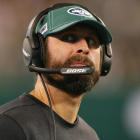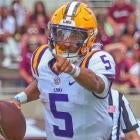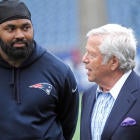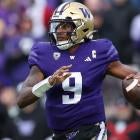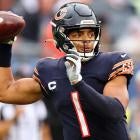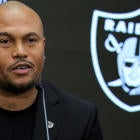Early in the NFL season, people like to freak out about what might appear to be global trends before there's any real evidence of said trends being the true reality. For instance, the Miami Dolphins are defying the sanctity of the NFL game by tearing apart their roster in the name of accumulating draft picks and trying to become better over the long haul. How dare they harm the integrity of this game!
Sorry. Anyway, the Dolphins are terrible. And so are the Jets! Which has led to two teams being underdogs by more than 20 points in the same week, the first time that has ever happened in a non-strike season* in NFL history.
Miami opened as 15.5-point underdogs to New England last week, closed as 18.5-point underdogs at home to the Patriots ... and they lost 43-0. Never mind they had a drive to try and cover before coughing up two pick sixes; they lost and they lost horribly. Which led to them immediately being turned into one of the biggest underdogs we've ever seen.
Pete Prisco and R.J. White join me on the Pick Six Podcast to break down who'll win these two crazy 20-plus point spread games plus the entire NFL slate; listen to the full show below and be sure to subscribe right here.
When the line opened against the Cowboys, Dallas was the biggest favorite it had been in more than 30 years, starting out as a 20.5-point favorite. That line has moved quickly, with the Cowboys settling in as a 22- or 23-point favorite. The look-ahead line (i.e. what Vegas identifies ahead of Week 2 as the likely Week 3 line) would have been more like 15.5 points. But when the Dolphins got destroyed by New England and then promptly traded Minkah Fitzpatrick to the Steelers, it became obvious everyone would take the Cowboys regardless of how big the number was.
And that's true -- Dallas is getting 78 percent of the tickets and 89 percent of the money according to The Action Network's data. There's no reason for this line to go down and it's not difficult to imagine the Cowboys beating the Dolphins 28-0. They're going to close as more than 20-point favorites barring something shocking happening between now and Sunday.
The same is true for the Patriots. New England was a 16-point favorite on the lookahead line against the Jets, but with Sam Darnold ruled out and Trevor Siemian knocked out for the year with an ankle injury, it's Luke Falk and David Fales against Bill Belichick and Tom Brady. What could go wrong?
As a result, the Patriots actually opened as a 17.5-point favorite before shooting up to a 21.5-point favorite thanks to everyone and their brother and their brother's mother hammering the Pats; 82 percent of the bets and 82 percent of the money is on New England per The Action Network.
Which teams can you back with confidence in Week 3? And which Super Bowl contender goes down hard? Visit SportsLine to see which NFL teams are winning more than 50 percent of simulations, all from the model that is up over $7,000 on its top-rated NFL picks.
Everyone is betting on the Pats and Cowboys. But maybe they shouldn't be. Historically speaking, underdogs of 20 points or more in NFL games have done very well against the spread.
*And this is where the whole non-strike thing comes into play: we have actually seen two teams as underdogs of 20 points or more in a previous season, but it doesn't really count for our purposes of accounting here. That's because in Week 5 of the 1987 season, in which there had been an NFL strike, we saw some players cross the picket line and step onto the field and go toe-to-toe with NFL replacement players.
Essentially the 49ers and Falcons game in Week 5 was Joe Montana (pretty famous, pretty good!) versus Erik Kramer (Sneaky NC State Wolfpack legend, long live #QBU, but undrafted in the 1987 season). That wasn't fair according to Vegas, so the line was a robust 23 points. The Falcons and Kramer actually covered with ease, as have a lot of teams on the list of 11 teams who have been underdogs by more than 20 points since the merger:
| Year/Week | Favorite | Underdog | Spread | Score | Fave Result |
|---|---|---|---|---|---|
2013 / Week 6 | -26.5 | 35-19 | Not Covered | ||
2013 / Week 3 | Jaguars | -20 | 45-17 | Covered | |
2011 / Week 13 | Patriots | -20.5 | 31-24 | Not Covered | |
2007 / Week 15 | Patriots | Dolphins | -22.5 | 28-7 | Not Covered |
2007 / Week 16 | Patriots | Jets | -20.5 | 20-10 | Not Covered |
2007 / Week 12 | Patriots | -24.5 | 31-28 | Not Covered | |
1993 / Week 14 | 49ers | -24 | 21-8 | Not Covered | |
1992 / Week 16 | 49ers | -20 | 21-14 | Not Covered | |
1991 / Week 7 | Colts | -20 | 42-6 | Covered | |
1987 / Week 5 | Cowboys | Eagles | -21.5 | 41-22 | Not Covered |
1987 / Week 5 | 49ers | Falcons | -23 | 25-17 | Not Covered |
A couple of interesting trends stand out here. First of all, the Patriots are prominently involved, which should surprise no one. Especially when it's the 2007 Patriots, who ran the table in the regular season. All three of the Patriots situations came in the second half of the season, after New England spent much of the year being a huge favorite and still covering. The Pats in 2007 went an absurd 9-1 against the spread to start the season. And in five of those games the Pats were favored by 14 points or more. 9-1! By the end of the year, Vegas was making the spreads so obnoxiously inflated that even New England couldn't cover them.
Going back in time a bit, the 49ers and Bills stand out because they were dominant franchises in an era before free agency truly took over the NFL. Parity wasn't as strong and the league was jam-packed with power franchises like Montana's 49ers and Jim Kelly's Bills. That 1991 Colts team was also a 1-15 squad that scored less than nine points per game (!) for the season.
More recently, we've seen the Colts involved, with the 2011 Colts -- a 2-14 squad that was in between Peyton Manning and Andrew Luck -- get smothered by an 8-3 Patriots team who still didn't cover.
The Jaguars of 2013 were just terrible, but they also managed to land both future Super Bowl teams on their schedule. This was a team that was vacillating between Blaine Gabbert and Chad Henne and drew a cresting defensive dynasty before anyone really knew what the Seahawks would become in 2013. The Seahawks were coming off a 29-3 curb-stomping of the 49ers in Week 2, while the Jaguars had managed 11 points in the first two weeks against the Chiefs (Andy Reid was in town but they were a two-win team the year before) and Raiders (a team that finished 4-12 and last was above .500 in 2002). So it made a ton of sense for the Jags to be huge dogs in Seattle and the outcome held up, with Seattle winning easily. The cover was actually in danger despite Seattle being up 31-0 -- the Jaguars made it 38-17 in the fourth quarter before a garbage time Tarvaris Jackson rushing touchdown made it appear as if there was never a sweat.
Later that year, the Jags ran into the buzzsaw that was Peyton Manning in his second year with the Broncos, when he broke every offensive record on the planet. Denver was mauling people that year, winning their first five games by 22, 18, 16 and 32 points before taking down the Cowboys in a wild 51-48 shootout and moving to 5-0 on the season. Their next game was against the 0-5 Jaguars, who had lost their games by 26, 20, 28, 34 and 14 points. The spread opened at Broncos -28, the largest in NFL history, and it didn't even feel like an overreaction at the time.
So what do these other games tell us about what might happen with these particular Week 3 games? I'm not sure that much.
The one trend that might stand out here when we're looking at these 11 matchups is the fact that, once you take out the strike season games and look at games from the first half of the season, the teams who are heavily favored are actually 2-1 against the spread. My only thought there? It's possible Vegas is cranking up the spread but we haven't fully accounted for just how good a particular favorite might be and how bad a particular underdog might be.
Watching the spreads fly up from those initial numbers to where they sit now certainly gives the impressions that the Dolphins and Jets could be worse than anyone things. Good luck laying that many points, though. Historically it's just tough to cover more than three touchdowns in the NFL.













